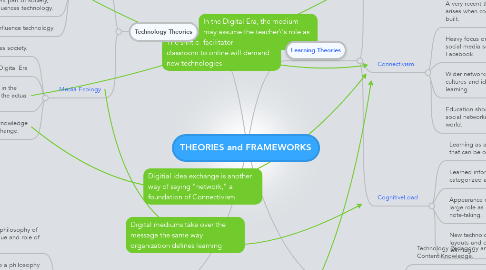
1. Technology Theories
1.1. SCOT
1.1.1. Social Construction of Technology.
1.1.2. Technology is influenced by the state of society.
1.1.3. Technology is influenced by human action.
1.1.4. As a prominent part of society, education influences technology.
1.1.5. Individuals can also influence technology
1.2. Media Ecology
1.2.1. The idea the technology influences society.
1.2.2. The World is currently in the Digital Era
1.2.3. The way ideas are exchanged (digitally in the Digital Era) carries more meaning than the actual idea.
1.2.4. Education turns into a knowledge base of digital idea exchange.
2. Philosophy of Teachnology
2.1. Teachnology is like a teacher's philosophy of teaching but focuses on the value and role of technology in education.
2.2. In the same way teachers write up a philosophy of teaching, they can record a philosophy of teachnology.
2.3. The philosophy of technology can be presented in more creative ways that in themselves reflect the teacher's values regarding technology.
2.4. Values regarding technology go beyond the classroom into PLN's and digital participation and citizenship.
3. Learning Theories
3.1. Constructivism
3.1.1. Learning is achieved by interacting with the environment and building connection.
3.1.2. The learner constructs his/her own knowledge by incorporating their own experience.
3.1.3. The teacher's role is as a facilitator.
3.1.4. Instruction begins with a problem and then cultivates skills required to solve it.
3.1.5. Education style is environment focused and relatively organic, loosely guided by an instructor.
3.2. Connectivism
3.2.1. A very recent theory that suggests that learning arises when connections are made and network is built.
3.2.2. Heavy focus on digital networking and social media such as Twitter and Facebook.
3.2.3. Wider networks incorporate other cultures and ideas which trigger new learning.
3.2.4. Education should move more and more into social networking online and in the digital world.
3.3. CognitiveLoad
3.3.1. Learning as a working memory that can be over or under loaded.
3.3.2. Learned information is constantly categorized and organized.
3.3.3. Appearance of things plays a large role as does style of note-taking.
3.3.4. New technologies for note taking effect layouts and organizational interpretations of learning.
